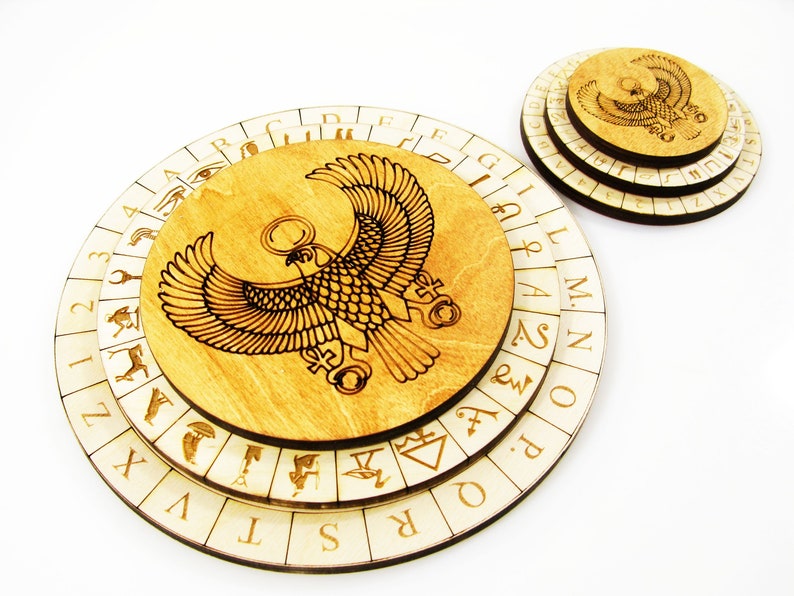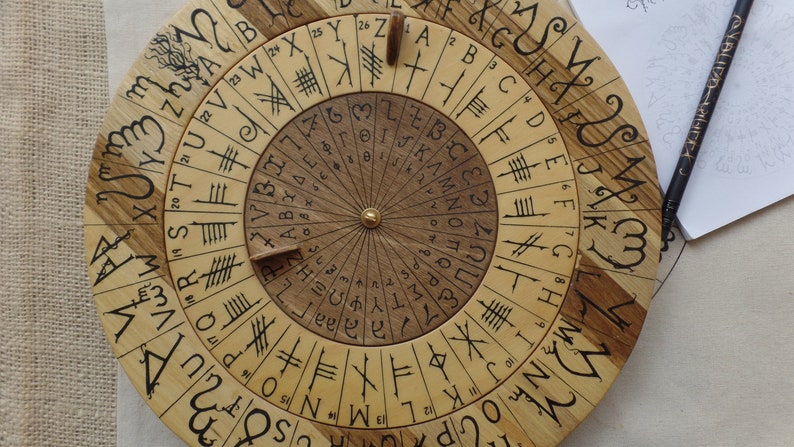

You rotate the outside ring and substitute the letters in your message found on the outside ring with the letters directly below on the inside ring (see diagram). It usually has two concentric wheels of letters, A through Z. The Captain Midnight decoder ring (which is an "encoder" ring as well) allows you to do a simple substitution cipher.
#CIPHER WHEEL CODE#
(ASCII stands for American Standard Code for Information Interchange, just in case you're interested.) The only difference between these and the spy codes is that the above examples are standardized so that everybody knows them. (Actually, substitution ciphers could properly be called codes in most cases.) Morse code, shorthand, semaphore, and the ASCII code with which these characters are being stored in inside my Macintosh are all examples. We use substitution ciphers all the time. To get a feel for these methods, let's take a look at some ciphers. Of course, you can use both methods, one after the other, to further confuse an unintended receiver as well. The resulting text of either enciphering method is called the ciphertext. Transposition ciphers keep all of the original letters intact, but mix up their order. Substitution ciphers replace letters in the plaintext with other letters or symbols, keeping the order in which the symbols fall the same. The easier the algorithm you choose, the more often you will have to change the key that unlocks the code - if you want to keep your enemy in the dark.Ĭiphers are broken into two main categories substitution ciphers and transposition ciphers. Therefore you must choose an algorithm (method) that is complicated enough so that by the time your opponent figures it out, the data will be worthless. On the other hand, you must also assume that your opponent has intercepted your enciphered message and is busy trying to break it. If you are in the battlefield and are receiving current tactical data, you want an algorithm that makes it easy to decipher the message in the heat of battle. The selection of the above three items - algorithm, key and period - depend on your needs. The next resident will have the locks changed to a different key to make sure that you cannot enter even though you may know the method. Now this method only works if you have the proper key to stick in the lock, and your key will be valid only as long as you are the resident of the particular abode. This process (the use of a key and a lock) is the method or algorithm. The period or time during which the key is valid.īy way of analogy, to get into your home you would put a key in a lock to open the door.The key used with the algorithm to allow the plaintext to be both enciphered and deciphered.The algorithm or method used to encipher the original message (known as the plaintext).(I told you the difference was fuzzy, and you can combine codes and ciphers by substituting one word for another and then mixing up the result.) We'll concentrate on ciphers.įor a cipher to be useful, several things must be known at both the sending and receiving ends. When you mix up or substitute existing letters, you are using a cipher. When you substitute one word for another word or sentence, like using a foreign language dictionary, you are using a code. If you don't know Greek (and not many of us do) the above letters could be a form of code themselves! Although the distinction is fuzzy, ciphers are different from codes. The study of enciphering and encoding (on the sending end), and deciphering and decoding (on the receiving end) is called cryptography from the Greek κρυπτός (kryptos), or hidden and γράφειν (graphia), or writing.

After all, you wouldn't want your competitor to know that you were about to acquire their company with a leveraged buy-out. Businesses also send data that has been encoded to try and protect trade secrets and back-room deals. In more serious uses, codes and ciphers are used by our military and diplomatic forces to keep confidential information from unauthorized eyes.


If the note was intercepted, your teacher, could learn nothing about your romance. Or perhaps you remember using special symbols to write notes to your "squeeze" in class. When you were a kid, did you have a "Captain Midnight" decoder ring? With it, you could send messages to a friends that no one else could read.


 0 kommentar(er)
0 kommentar(er)
